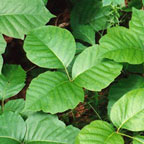
Vol. III, No. 6, June 2004
- The Role of the Contractor and the Contractual Process
- Itchy, Scratchy, Savvy... Poison Ivy
- Chemicals are Making Children Less Intelligent
- Helmets for Tricycles
- 2004 National Children & Youth Garden Symposium
- Starting a New Child Care Project?
- Early Childhood Design Institute Sets Dates for 2005
- Recent Projects
Itchy, Scratchy, Savvy... Poison Ivy
Poison ivy rash is an unfortunate byproduct of being outdoors. Maybe you have children who have come to the center with poison ivy or maybe they have picked it up from being on your outdoor play yard. This article will help you understand how poison ivy works.
The rash we get from our exposure to poison ivy (as well as poison oak and
sumac) is an allergic reaction to contact with an oil called urushiol (oo-ROO-she-ol).
All species of poison ivy, oak and sumac have urushiol in their roots, stems,
leaves and fruit. The oil  or
sap is released when plants are bruised. For this reason, poison ivy rashes
are more common in the spring and early summer when leaves and stems are tender.
The sap may be deposited on the skin by direct contact with the plant, through
contact with contaminated objects such as shoes, clothing, tools and animals,
or as airborne urushiol particles from burning plants.
or
sap is released when plants are bruised. For this reason, poison ivy rashes
are more common in the spring and early summer when leaves and stems are tender.
The sap may be deposited on the skin by direct contact with the plant, through
contact with contaminated objects such as shoes, clothing, tools and animals,
or as airborne urushiol particles from burning plants.
We're betting that you still cling to at least one of the poison ivy myths below. Now is a good time to set the record straight:
- Myth 1 - Scratching poison ivy blisters spreads the rash.
Not true. Fluid discharged from blisters will not spread the rash. Well before the blisters form, however, you may spread the urushiol on your hands to other parts of your body.
- Myth 2 - Poison ivy is contagious.
Not true. The rash is simply a reaction to urushiol. The rash cannot pass from person to person; only the urushiol can be spread by direct contact.
- Myth 3 - You can "catch" poison ivy by being near it.
Not true. Direct contact or contact with smoke from burning plants is needed to introduce urushiol onto the victim.
- Myth 4 - Once allergic, always allergic to poison ivy.
Not true. A person's sensitivity changes over time, even from season to season. People who were sensitive to urushiol as children may not be allergic as adults.
- Myth 5 - There's no need to worry about dead plants.
Not true. Urushiol remains active on any surface, including dead plants, for up to 5 years!
- Myth 6 - Covering up is good protection.
Partly true. Urushiol can stick to your clothes, which you can touch and spread to your skin later.
Vol. III, No. 6, June 2004
- The Role of the Contractor and the Contractual Process
- Itchy, Scratchy, Savvy... Poison Ivy
- Chemicals are Making Children Less Intelligent
- Helmets for Tricycles
- 2004 National Children & Youth Garden Symposium
- Starting a New Child Care Project?
- Early Childhood Design Institute Sets Dates for 2005
- Recent Projects

